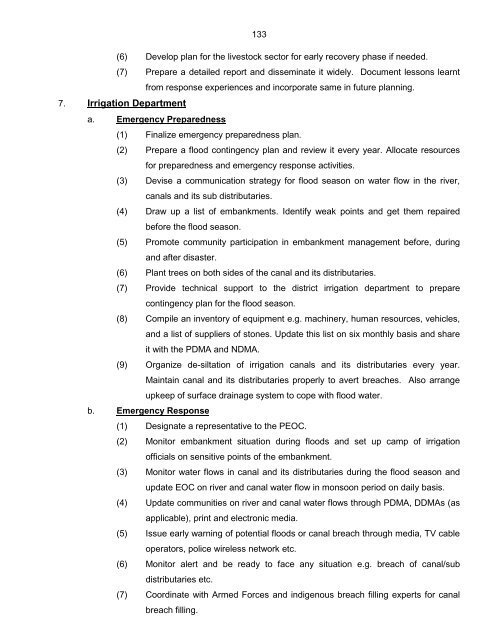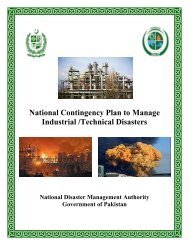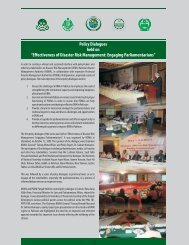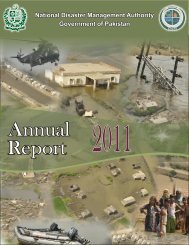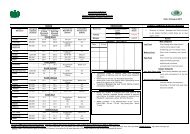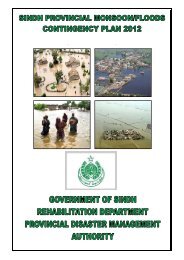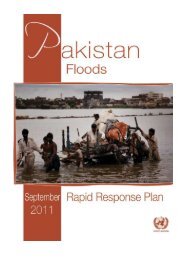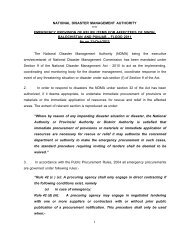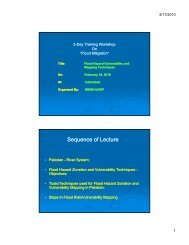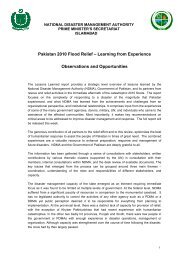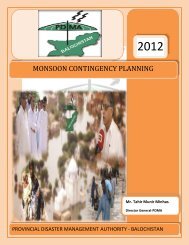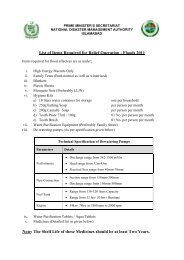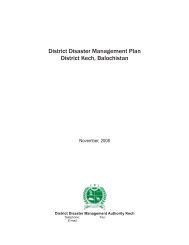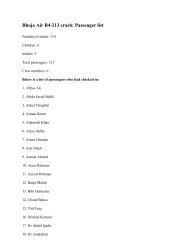National Disaster Response Plan (NDRP) March 2010 - NDMA
National Disaster Response Plan (NDRP) March 2010 - NDMA
National Disaster Response Plan (NDRP) March 2010 - NDMA
Create successful ePaper yourself
Turn your PDF publications into a flip-book with our unique Google optimized e-Paper software.
133<br />
(6) Develop plan for the livestock sector for early recovery phase if needed.<br />
(7) Prepare a detailed report and disseminate it widely. Document lessons learnt<br />
7. Irrigation Department<br />
from response experiences and incorporate same in future planning.<br />
a. Emergency Preparedness<br />
(1) Finalize emergency preparedness plan.<br />
(2) Prepare a flood contingency plan and review it every year. Allocate resources<br />
for preparedness and emergency response activities.<br />
(3) Devise a communication strategy for flood season on water flow in the river,<br />
canals and its sub distributaries.<br />
(4) Draw up a list of embankments. Identify weak points and get them repaired<br />
before the flood season.<br />
(5) Promote community participation in embankment management before, during<br />
and after disaster.<br />
(6) <strong>Plan</strong>t trees on both sides of the canal and its distributaries.<br />
(7) Provide technical support to the district irrigation department to prepare<br />
contingency plan for the flood season.<br />
(8) Compile an inventory of equipment e.g. machinery, human resources, vehicles,<br />
and a list of suppliers of stones. Update this list on six monthly basis and share<br />
it with the PDMA and <strong>NDMA</strong>.<br />
(9) Organize de-siltation of irrigation canals and its distributaries every year.<br />
Maintain canal and its distributaries properly to avert breaches. Also arrange<br />
upkeep of surface drainage system to cope with flood water.<br />
b. Emergency <strong>Response</strong><br />
(1) Designate a representative to the PEOC.<br />
(2) Monitor embankment situation during floods and set up camp of irrigation<br />
officials on sensitive points of the embankment.<br />
(3) Monitor water flows in canal and its distributaries during the flood season and<br />
update EOC on river and canal water flow in monsoon period on daily basis.<br />
(4) Update communities on river and canal water flows through PDMA, DDMAs (as<br />
applicable), print and electronic media.<br />
(5) Issue early warning of potential floods or canal breach through media, TV cable<br />
operators, police wireless network etc.<br />
(6) Monitor alert and be ready to face any situation e.g. breach of canal/sub<br />
distributaries etc.<br />
(7) Coordinate with Armed Forces and indigenous breach filling experts for canal<br />
breach filling.


